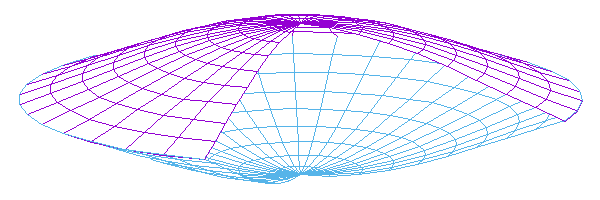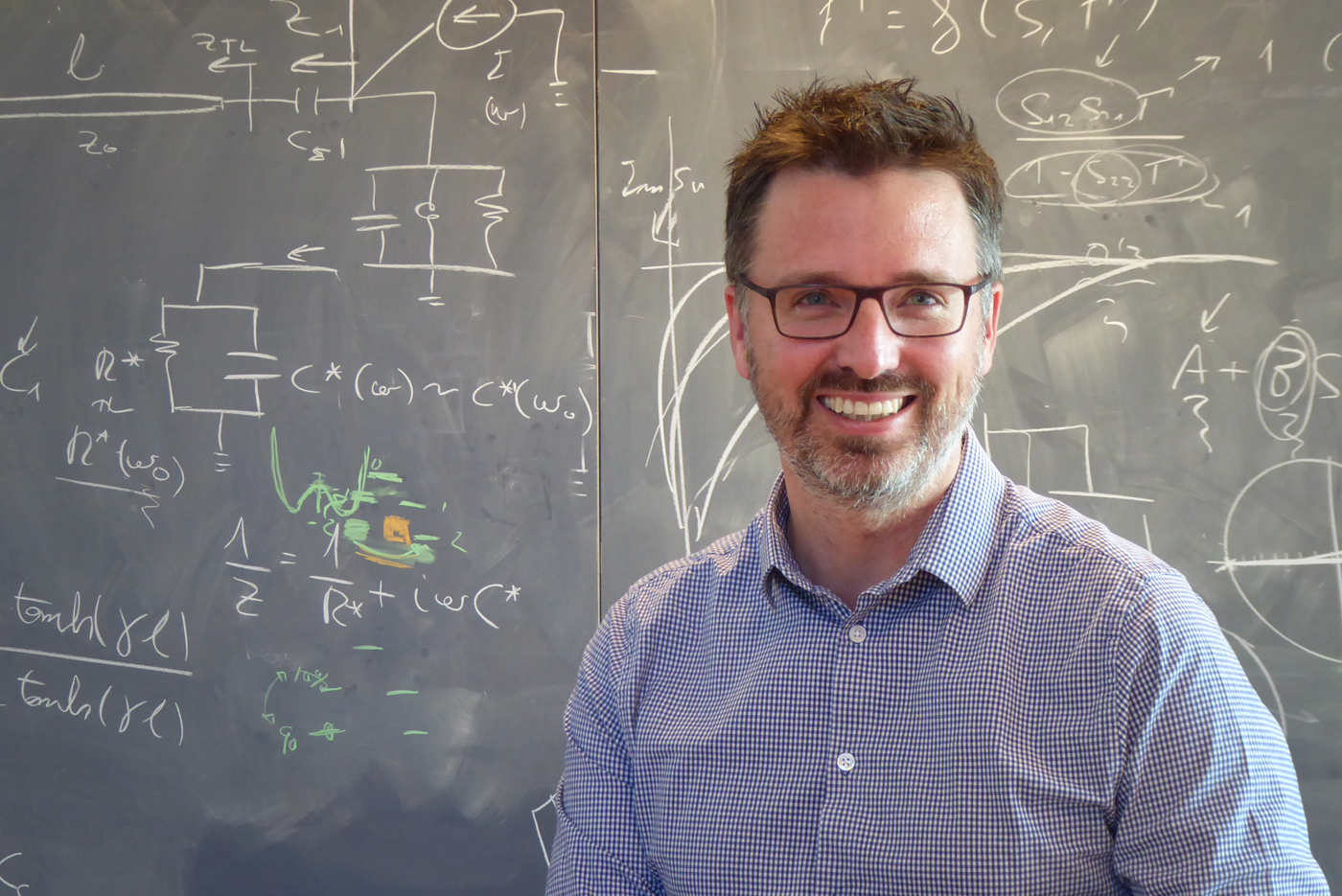Quantum physicist Dr Gary Steele has been appointed Antoni van Leeuwenhoek Professor. With his devices, which combine mechanics with microwaves, Steele explores the far limits of quantum mechanics. Who says real things cannot be in two states at the same time?
Gary Steele: “Nobody has ever made this type of quantum superposition for heavy objects.” (Photo: Jos Wassink)
Dr Steele, who runs a lab in the Quantum Nanoscience Department, part of the Kavli Institute of Nanoscience, in the TU Delft Faculty of Applied Sciences, sucks the entropy out of super-cooled mechanical oscillators to force them into their ground state. From there, he wants to bring them into a controlled superposition of two vibrations at the same time. If he succeeds, he will have entered a domain somewhere in between gravity and quantum mechanics that theoretical physicists don’t know how to describe. Steele joyfully describes it as a mechanical version of Schrodinger’s Cat.
Steele, who was born in Canada in 1976, has made steady progress as a researcher at TU Delft, with a Veni award in 2009 and a Vidi award in 2014. He had a remarkable Nature publication in 2015, followed by a ERC consolidator grant in 2016. His recent AvL Professorship crowns his career so far.
‘We smashed them very much like how a mirror would smash if you would hit it with a hammer’
I see your field of research described as ‘optomechanics’. What is that?
It is in fact a bit of a misnomer, because we don’t work with optics. But we do work with mechanics. I started my group working on nanotubes which are nanometre-sized. We’ve gone a bit bigger lately. We now have big things that shake, like a membrane that is one by one millimetre, but it’s only 50 nanometres thick. We’ve written about it in a Nature Communications article.”
The article says you trap microwaves in a box. How does that go?
“We trap a microwave in a matchbox-sized metal box. When closed, the box is a little pit for microwaves. A microwave gets in, but it can’t go anywhere. We have a wire sticking in through a tiny hole. That allows us to send stuff in and measure what comes out. The hole is so small that a wave bounces inside the box 100,000 times before it goes out the hole again.”
The article also says you use microwaves to cool the system. How does that work?
“You’ve got to realise that everything around you is moving around with Brownian motion. Even at 10 milli-Kelvin (minus 273 degrees Celsius, jw,) things are bouncing around like crazy. Quantum physicists count the energy in levels related to an atom’s absorption frequency. Even at 10 milli-Kelvin, that is 2,000 times the elemental energy step. So if you want to get to the ground level, there is a long way to go.”
So how do you get the energy out?
“The way we do it is using a trick analogous to laser cooling. Every time you scatter a photon, you take away some of the atom’s energy. That’s the trick of laser cooling. We do the same thing with microwaves. Just like the atom has a certain frequency associated with its atomic transition, our microwave cavity also has a certain frequency associated with its resonance. Now the laser has been replaced by the microwave signal, like in your microwave at home, only fancier and more expensive. What we try to do is shine this at our circuit, but we make the frequency a little bit too low by exactly the mechanical frequency. This can cause the microwave signals and the mechanical vibrations to mix together. That means that mechanical vibrations can shift the microwave frequency up or down. If up, they go into the cavity resonance. Then the process kicks the photon’s energy up. Every time we do that, we take away one phonon from our mechanical resonator, and we cool it down. We’re kind of sucking out the entropy. The photons are sucking out the phonons like a vacuum cleaner.”
Why do you want to cool the system to its ground state?
“First of all, because it’s cool, haha. But what’s important in quantum mechanics is to know in what energy state your system is. From there, you can calculate stuff or you can do stuff. In quantum mechanics, if you don’t know where to start, then you can’t calculate anything. So the ground state is literally the starting point. From a zero-state energy, you can make it one by kicking it a little bit. What we really want to make is things like zero plus one. Or zero plus ten. Because we want to make our mechanical resonator into a quantum mechanical superposition. Ultimately, we want to make something like this: a quantum mechanical version of Schrodinger’s cat.”
‘We’re working out funny ways to kick both ways at the same time’

“Classically, if you hit a drum, it vibrates up and down. The most quantum mechanical type of vibration you can think of is where the drum is vibrating up and down at the same time. As a function of time, it kind of falls back onto itself, and it blows back out of itself. It’s what we call a mechanical Schrodinger cat state, a state of the membrane being in two different places at the same time. What we’re currently trying very hard to do in our group is to make our drum make this funny shake. One limitation is the way that we can hit it. If I hit with my finger, it doesn’t go up and down at the same time, it just goes down and then up again. So we’re currently working out some funny ways to kick our drum both ways at the same time.”
Why would you want to do that?
“Nobody has ever made this type of quantum superposition for heavy objects. People have made it for atoms, or electrical oscillations in superconducting qubits, people have made it from photons, but nothing with a lot of mass. The membrane we work with is heavy in comparison, it weighs 20 orders of magnitude more than an electron. There are people who say that quantum mechanics should break down when gravity plays a role. There are predictions on when this should happen. Our experiment would in principle be the first one in the history of science that would be able to test the influence of gravity on the evolution of quantum mechanics. So that’s kind of pretty out there.”
That sounds pretty adventurous.
“In principle, when we can observe these coherent oscillations of the coherence of this quantum state, it means that space-time is in a quantum superposition. And actually, the problem with that is that mathematicians do not even know how to approach that because gravity and quantum mechanics are incompatible. And nobody knows how to fix that, still. Amazingly.”
And you’re approaching the paradox experimentally now?
“These experiments have the capability to reach these limits. We know exactly what we need to do, it’s still just a little bit technically challenging. But it’s actually not totally infeasible.”
In 2015 you had this Nature publication on the vibrating membrane on top of a microwave cavity. When are we going to see an article on the membrane oscillating in superposition?
“That’s a very interesting question. Right now we’ve spent about three years breaking our chips. We smashed them very much like how a mirror would smash if you would hit the mirror with a hammer. These things are super delicate, and that’s all that we have discovered. So we’re actually completely rebooting the whole system, we have some very clear ideas on what our next steps will be, we have a new PhD student who started a year ago, and our plan is to get the system back up and running.”
What does the appointment mean to you personally?
“For me, it is an important recognition of my research by the university. Having spent much of my younger academic career in Canada and the US, I am more used to a North-American academic system: in this system, full professorship is not usually such a big deal: bigger hurdles usually lie at the hiring stage into the Assistant Professor level, and the tenure stage where people are typically promoted to Associate Professor. However, in the years that I’ve been in Delft, I’ve learned that this viewed differently in Holland, and I am proud now also to received this prestigious appointment. And it will also mean I will get to go this year to the hoogleraardiner as a professor instead of a ‘significant other’.”
What does it change for your work?
“In practice, not much really: in our department, we do our best to emulate the North-American flat structure, which means that our people already enjoy both the freedom and responsibility of running an independent group starting from their appointment as UD. From a practical point of view, I will continue to run my group as I have done, now with a new title on the door. It will, of course, open me up to more participation in organisational tasks as at a higher level in the faculty and university, which I am happy to get involved in.”
Heb je een vraag of opmerking over dit artikel?
j.w.wassink@tudelft.nl


Comments are closed.